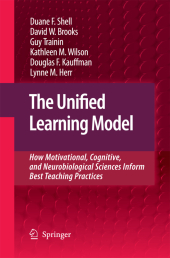 Neuerscheinungen 2014Stand: 2020-02-01 |
Schnellsuche
ISBN/Stichwort/Autor
|
Herderstraße 10
10625 Berlin
Tel.: 030 315 714 16
Fax 030 315 714 14
info@buchspektrum.de |

David W. Brooks, Duane F. Shell, Guy Trainin
(Beteiligte)
The Unified Learning Model
How Motivational, Cognitive, and Neurobiological Sciences Inform Best Teaching Practices
2010. 2014. xi, 212 S. 235 mm
Verlag/Jahr: SPRINGER NETHERLANDS; SPRINGER 2014
ISBN: 9400791380 (9400791380)
Neue ISBN: 978-9400791381 (9789400791381)
Preis und Lieferzeit: Bitte klicken
Human learning patterns in the classroom, from the pre-school to post-graduate level, are presented in this volume, which presents a scientific learning model. Training in the business world and armed forces are also among the various examples presented.
This is a book about how humans learn. Our focus is on classroom learning although the principles are, as the name of this book indicates, universal. We are concerned with learning from pre-school to post-graduate. We are concerned with most bu- ness, industrial and military training. We do not address how infants learn how to speak or walk, or how grown-ups improve their tennis swing. We do address all learning described by the word "thought", as well as anything we might try to teach, or instruct in formal educational settings. In education, the words theory and model imply conjecture. In science, these same words imply something that is a testable explanation of phenomena able to predict outcomes of experiments. This book presents a model of learning that the authors offer in the sense of scientists rather than educators. Conjecture implies that information is incomplete, and so it surely is with human learning. On the other hand, we assert that more than enough is known to sustain a "scienti?c" model of learning. This book is not a review of the literature. Instead, it is a synthesis. Scholars and many teachers likely have heard much if not most or even all of the information we use to develop the uni?ed learning model. What you have not read before is a model putting the information together in just this way; this is the ?rst one.
From the reviews:
"This is an excellent book about how learners learn and behave in a classroom and how this understanding about learning could be put to use by teachers for effective teaching. ... the authors have successfully tied different ideas, concepts, and theories of learning into one model that is easy to understand even for those readers who do not have a background in education. I highly recommend this well-written and engaging book to all teachers, researchers, and students." (Sandhya N. Baviskar, The American Biology Teacher, Vol. 73 (4), April, 2011)
"The writers of The Unified Learning Model (ULM) intend their book to satisfy classroom teachers as well as teaching and learning researchers. The book is divided into chapters within two major sections, developing the model and applying the model. ... This book reinforced for me the value of modeling and practicing problem solving for students. ... It gives the reader a variety of things to contemplate about memory and learning, the most challenging and enjoyable being the ULM itself." (Greg Diersen, The American Biology Teacher, Vol. 73 (4), April, 2011)


